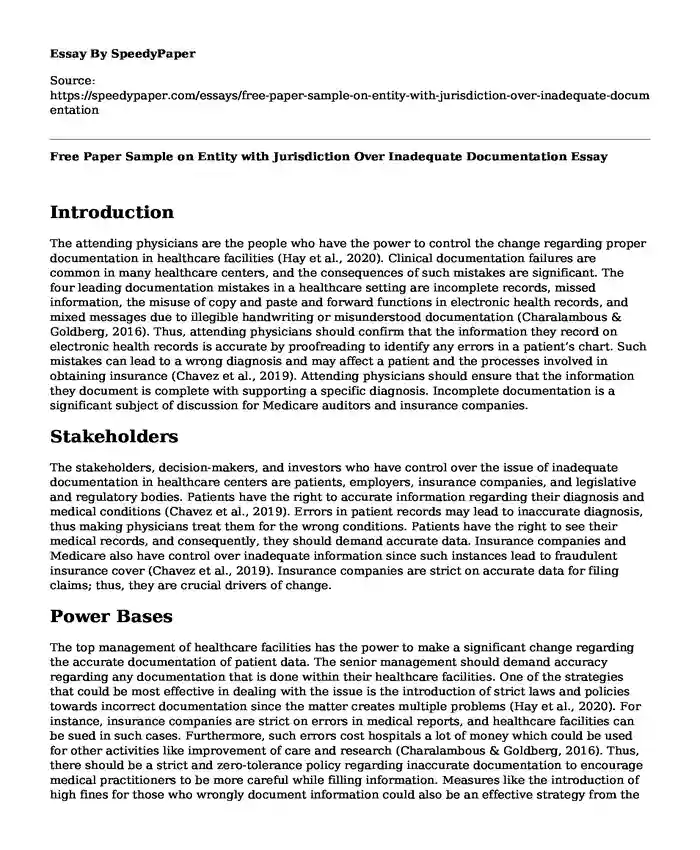
| Type of paper: | Essay |
| Categories: | Health and Social Care Nursing Ethics |
| Pages: | 3 |
| Wordcount: | 684 words |
Introduction
The attending physicians are the people who have the power to control the change regarding proper documentation in healthcare facilities (Hay et al., 2020). Clinical documentation failures are common in many healthcare centers, and the consequences of such mistakes are significant. The four leading documentation mistakes in a healthcare setting are incomplete records, missed information, the misuse of copy and paste and forward functions in electronic health records, and mixed messages due to illegible handwriting or misunderstood documentation (Charalambous & Goldberg, 2016). Thus, attending physicians should confirm that the information they record on electronic health records is accurate by proofreading to identify any errors in a patient’s chart. Such mistakes can lead to a wrong diagnosis and may affect a patient and the processes involved in obtaining insurance (Chavez et al., 2019). Attending physicians should ensure that the information they document is complete with supporting a specific diagnosis. Incomplete documentation is a significant subject of discussion for Medicare auditors and insurance companies.
Stakeholders
The stakeholders, decision-makers, and investors who have control over the issue of inadequate documentation in healthcare centers are patients, employers, insurance companies, and legislative and regulatory bodies. Patients have the right to accurate information regarding their diagnosis and medical conditions (Chavez et al., 2019). Errors in patient records may lead to inaccurate diagnosis, thus making physicians treat them for the wrong conditions. Patients have the right to see their medical records, and consequently, they should demand accurate data. Insurance companies and Medicare also have control over inadequate information since such instances lead to fraudulent insurance cover (Chavez et al., 2019). Insurance companies are strict on accurate data for filing claims; thus, they are crucial drivers of change.
Power Bases
The top management of healthcare facilities has the power to make a significant change regarding the accurate documentation of patient data. The senior management should demand accuracy regarding any documentation that is done within their healthcare facilities. One of the strategies that could be most effective in dealing with the issue is the introduction of strict laws and policies towards incorrect documentation since the matter creates multiple problems (Hay et al., 2020). For instance, insurance companies are strict on errors in medical reports, and healthcare facilities can be sued in such cases. Furthermore, such errors cost hospitals a lot of money which could be used for other activities like improvement of care and research (Charalambous & Goldberg, 2016). Thus, there should be a strict and zero-tolerance policy regarding inaccurate documentation to encourage medical practitioners to be more careful while filling information. Measures like the introduction of high fines for those who wrongly document information could also be an effective strategy from the top management.
Conclusion
Healthcare facilities should significantly invest in training all medical practitioners and other staff in their jurisdiction. The human resource management should devise strategies to train all workers in healthcare facilities regarding on how to correctly document data and the measures to use to avoid errors. For instance, employees should be encouraged to proofread what they key in in electronic health records. Some of the most common mistakes in electronic health records are those of data entry and copy-and-paste mistakes (Chavez et al., 2019). Secondly, nurses and doctors should be trained to use more legible handwritings while writing their medical notes to allow others to document accurate information. Sometimes, the inaccuracy of data is due to poor handwriting that may be misinterpreted.
References
Charalambous, L., & Goldberg, S. (2016). Gaps, Mishaps and Overlaps. Nursing Documentation: How Does It Affect Care? Journal of Research in Nursing, 21(8), 638-648.
https://journals.sagepub.com/doi/abs/10.1177/1744987116678900
Chavez, M. A., Duffy, A., Rugs, D., Cowan, L., Davis, A., Morgan, S., & Powell-Cope, G. (2019). Pressure Injury Documentation Practices in the Department of Veteran Affairs: A Quality Improvement Project. Journal of Wound Ostomy & Continence Nursing, 46(1), 18-24.
https://cdn.journals.lww.com/jwocnonline/FullText/2019/01000/Pressure_Injury_Documentation_Practices_in_the.3.aspx
Hay, P., Wilton, K., Barker, J., Mortley, J., & Cumerlato, M. (2020). The Importance of Clinical Documentation Improvement for Australian Hospitals. Health Information Management Journal, 49(1), 69-73.
https://journals.sagepub.com/doi/abs/10.1177/1833358319854185.
Cite this page
Free Paper Sample on Entity with Jurisdiction Over Inadequate Documentation. (2023, Oct 28). Retrieved from https://speedypaper.net/essays/free-paper-sample-on-entity-with-jurisdiction-over-inadequate-documentation
Request Removal
If you are the original author of this essay and no longer wish to have it published on the SpeedyPaper website, please click below to request its removal:
- Essay Sample on the Theory of Biogenesis
- The Role of Midwife from Legal and Ethical Perspective, Essay Example
- Should Physician-Assisted Suicide/Euthanasia Be Legalized? - Essay Sample
- Free Essay. Annotated Bibliography on Leprosy
- Free Essay Example. Seasonal Food Guide
- Free Essay: A Qualitative Research Critique on Patient Involvement for Improved Patient Safety
- Paper on Food Microparticles and Lymphatic System Interaction: A New Perspective on Health
Popular categories




